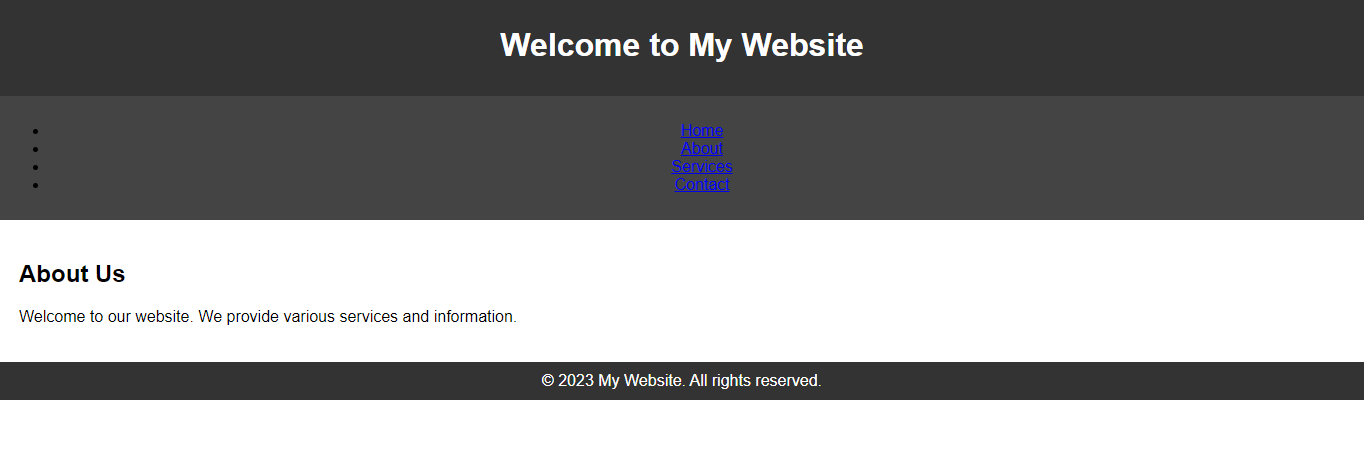Semantic in HTMLWhat is Semantics in HTML?The term "semantic" in HTML describes how HTML elements are used in a structured and meaningful way to describe the content and its surroundings on a web page. To help web browsers and assistive technologies (like screen readers) correctly understand and interpret the content, semantic HTML elements give meaning to the content they enclose. Semantic HTML tags include the following: header, nav, main, article, section, aside, footer, figure, figcaption, blockquote, cite, etc. These components give your website's pages a distinct structure that helps search engines understand the content and may enhance your website's search engine optimization (SEO). They also improve accessibility by giving assistive technologies useful data, which increases the accessibility of web content for those with disabilities. Why Use Semantic Elements?HTML should use semantic elements for several key reasons. 1. Clarity and understandability Semantic elements offer a meaningful and clear way to organize web content. Using semantic elements, such as header>, nav>, article>, and footer>, makes it simpler for developers and other stakeholders to comprehend the function and hierarchical order of various web page components. 2. Accessibility Semantic HTML increases web accessibility. The semantic structure of a page is used by assistive technologies like screen readers to communicate information to users with disabilities. You can make your website more inclusive and accessible to a larger audience by using semantic elements. 3. Search engine optimization Search engines use semantic HTML to comprehend the content and context of web pages. Your website's search engine ranking and visibility can be enhanced by using the right semantic elements to describe your content (such as using main headings), which will generate more organic traffic. 4. Future Proofing Semantic elements are made to be forward-compatible, making them future-proof. Semantic HTML is still applicable and adaptable as new web technologies and standards are developed. As a result, because of semantic elements, our content will not break, or it will not become outdated as web technologies advance. 5. Consistency and Maintainability Semantic HTML encourages consistency in web development practices and maintainability. It's simpler to update and maintain code when you and your team adhere to semantic conventions. This consistency fosters more effective teamwork and lowers the possibility of making mistakes. 6. Responsive Design Semantic elements combine well with JavaScript and CSS to create responsive web designs. With the help of the semantic element, we can use it to specify the organization and intent of the content. We can use CSS to create responsive styling and adapt to different screen sizes and devices. Delivering a consistent user experience across various platforms depends on this. 7. Documentation and Communication Semantic HTML is a form of documentation for your web page in terms of documentation and communication. It helps other developers who might work on the project understand and modify the code by explaining your content's intended structure and meaning. In other words, we can say that with semantic elements, we can produce crucial content that is well structured, and anyone can use that content, which is also future-proof. It benefits users, search engines, assistive technologies, and developers, improving the user experience on the web. ExampleLet's take a basic example of an HTML program in which we can see how semantic elements are used to create a web page's structure. In this demonstration, we'll use semantic elements to build a webpage with a header, navigation menu, primary content area, and footer: In this instance:
Developers and browsers can both understand, thanks to these semantic elements, what each webpage section is meant for. The page has also been styled with basic CSS for a better visual presentation. Output: 
Advantages of Semantic Elements in HTMLThere are some advantages of semantic elements that help in various ways. Some are as follows:
Semantic HTML, in other words, makes life simpler for users and developers by assisting in creating understandable, accessible, and attractive websites. Disadvantages of Semantic Elements in HTMLAlthough using semantic HTML elements has many benefits, there are no unavoidable drawbacks. However, in some circumstances, specific considerations might become relevant:
In summary, using semantic HTML elements has no inherent disadvantages. The difficulties that might arise have more to do with the learning curve, browser compatibility, and ensuring that semantic elements are used sparingly and appropriately. Semantic HTML improves web accessibility and search engine optimization, which benefits web development.
Next TopicAccordion HTML
|
 For Videos Join Our Youtube Channel: Join Now
For Videos Join Our Youtube Channel: Join Now
Feedback
- Send your Feedback to [email protected]
Help Others, Please Share









